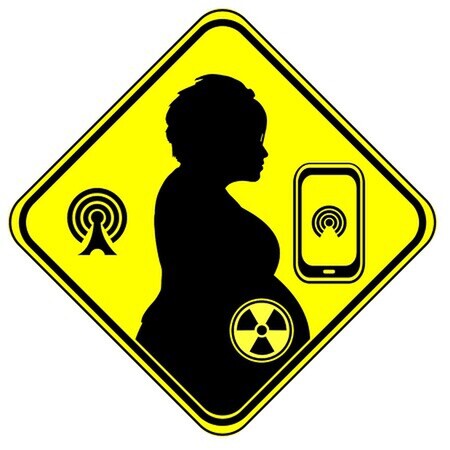There is some conflicting information surrounding the effects of radio frequency electromagnetic waves (EMW) and their effects on the body and fertility. There is a large body of evidence however that supports the hypothesis that radiation from mobile phones has negative effects upon the body and fertility especially that of males. It has been difficult to conduct repeatable, strong experiments. This means that previous studies have produced antagonistic data. With increasing interest into this hypothesis, stronger and less fallible experiments and research have been conducted. If this is true of mobile EMW then as a technologically advancing race with evidenced lowered fertility rates we need to consider how we avoid these problematic EMWs.
Radiation is categorised as either non-ionising or ionising. That emitted from mobile phones is non-ionising, which is less ominous than the ionising radiation from sunlight and x-rays. Non-ionising REM waves are considered too weak to break biological chemical bonds whereas ionising waves break bonds and damage human tissue. Some research papers however dispute this, stating mobile radiation does in fact have the capacity to break chemical bonds within the body and cause tissue damage.
The effects of cell phone radiation are broken into two classifications. Thermal effects are caused by high frequencies that increase in heat and may heat the tissues in contact with the phone and increase the body’s overall temperature. This may cause dysfunction to cellular development and function, especially of the eyes and testes which are at particular risk due to having fewer blood vessels. Non-thermal effects may cause disruption to the integrity of the cell membranes by interfering with the cell membrane electrical potentials. It may alter endothelial tissue function, alter the blood-brain barrier, cellular signalling and in turn affect the immune system and nervous system excitability.
Mobile radiation is measured in terms of SAR (specific absorption rate). This measures the effect of radio frequency EM waves on the body. It is calculated by watt/kg ratio. Measurements above 1.6 watts/kg are deemed dangerous. SAR rates can depend on the proximity to a cell site, proximity of the phone to the body when in use, the transmission type (or mode of use –whether in standby or in talk mode), the use of hands free.
Data has been antagonistic due to the inability to perform repeatable studies. It has proven difficult to find an appropriate control group, as most people of current reproductive age have had exposure to telecommunications and older generations experience other fertility issues. Therefore most studies utilise those who have had ‘minimal’ exposure as a baseline for controls. Other issues to be factored in are the type of cell phones used; the proximity of the cell phone to reproductive organs, the length of exposure and the transmission type. Animal studies pose issues as well. SAR is based on body weight, of which animals have significantly less and they are anatomically quite different to human subjects. In vitro ejaculated samples have also been used. Questions as to the appropriateness of this are also raised.
A large number of retrospective studies, observational studies and a few prospective in vitro studies have been utilised in the past to conclude that there are a number of health issues caused by mobile EMW. Some of these issues include; disturbances to sleep patterns, neuroendocrine, EEG’s, hormone secretions, increased reactive oxidation stress (ROS) and reduced sperm motility and viability. General fatigue, lowered concentration, and increased blood pressure levels have also been noted. It is however not completely clear what effect mobile radiation has in order to produce these health issues. There are other studies that negate these findings also.
Several studies found a direct link between increased cell phone use and lowered progressive sperm motility, increased non-progressive sperm motility, increased ROS and decreased count and abnormal morphology of sperm. Where one animal study agreed with all of the above, other studies found no change when they repeated the study. Anatomical changes were noted by an animal study, where teste size and seminiferous tube diameter were reduced.
An animal study showed thermal effects caused no change to male fertility; whereas other animal and human studies showed non-thermal effects caused oxidative stress. Sperm is high in polyunsaturated fats and have low stores of antioxidant enzymes making them more susceptible to ROS. (This was also shown to affect the endometrium lining of the uterus.) It has been hypothesised that RF EMW may reduce antioxidant levels especially that of superoxide dismutase and glutathione peroxidase. These results were seen with SAR levels of only 0.09w/kg. Research reviews concluded that depending on SAR, handling and use of phone, EMW frequency and proximity to reproductive organs, sperm were definitely affected by cellular radiation induced ROS.
A 2007 study linked GSM (2G) phones to increased abnormal sperm morphology and reduced progressive motility dependant on the duration of exposure. (There are conflicting reports as to whether 2G SAR ratings were lower than 3G, but it is thought that a 2G phone had to work harder therefore would emit more radiation). Studies have shown a number of methods by which mobile radio frequency EMW radiation may negatively affect sperm health and therefore male fertility. Some of these methods are:
Radiation may interfere with sperm cell membrane potential and signal transmission.
Radiation may affect the mitochondria of the sperm, reducing motility.
Sperm apoptosis may also be affected causing an increase in morphological issues.
Phones with 0.9w/kg SAR were seen to affect the DNA and chromatin of mice. It is unknown if this was caused directly by the EMW radiation or by the induced ROS.
Lowered testosterone levels were also seen in test groups of mice. This is probably caused by an effect on the testosterone producing Leydig cells in the testes rather the pituitary as luteinising and follicle stimulating hormones were not affected.
In 2014 Dr. James Hotaling, an expert in male fertility and andrology negated any claims of mobile phone radiation causing male infertility. He stated he had never seen any conclusive data to substantiate these claims and suggested a selection bias, as participants were generally sourced from fertility clinics. He also mentioned that sperm counts naturally varied, hour to hour, day to day, month to month. His view is that the main factors affecting male infertility were diet, exercise and age.
More recent articles have published the results of studies negating Dr. Hotaling’s claims against mobile radiation induced male infertility. In Feb 2016 The Telegraph published an article about a recent study into mobile phone use and male infertility. The study followed 100 men for 1 year and found a number of men talked on the phone while it was charging, kept the phone only a few cm from the bed while they slept and found that less than 1 hour a day of use can “cook” sperm and significantly lower sperm count whether it was close to their testes or within 1-2 ft of their body. These findings were published in the Journal of Reproductive Biomedicine. Another article in the NZ Herald in Sept 2016 discussed a review of 27 studies that showed consistent results of lowered count and possible DNA damage from phones kept in pockets. The article noted an 8% and 9% decrease in motility and viability respectively.
These articles don’t often mention the possible link between reproductive cancers and cell phone use. In 2011 the International Agency for Research on Cancer (IARC) rated mobile radiation as a 2B carcinogen, deeming it a possible carcinogen to humans. One may then assume a relationship between increased prostate cancers and cell phones in pockets.
So within our advancing technological age where ever developing telecommunication is an accepted and expected part of daily life, how do we reduce our exposure to mobile emitted radio frequency electromagnetic waves or radiation? Surely new regulations should be considered and put in place to protect our population from this radiation? Especially with a population that is experiencing increased infertility? One US telecommunication company reduced their frequency from 1800MHz to 850MHz and found their users experienced better quality calls. Lower frequencies may cause less damage to our bodies. Maybe this is one aspect to be considered.
Until such time individuals can follow the following guidelines:
Limit cell phone call to only those that are necessary.
Don’t carry your phone directly on your body. (Even switched off phones may emit radiation.)
Only use your phone when there is optimal reception. (Low reception increases the emissions of radiation. Each signal bar missing increases exposure several hundred times.)
Don’t use your phone in a moving vehicle. (This causes constant scanning by the phone for cell antenna/sites and this increases radiation emissions. GSM phone are worse than 3G and 4G for this.)
Use speaker phone where possible. (This allows you to hold the phone further away from your body. It can however increase the magnetic radiation levels.)
Use a headset. Preferably the air tube type. These are specifically designed to reduce mobile radiation. (These use a hollow, flexible air tube that transmits sound from the phone to the ear. They do not use metal, which can act as a conductor of radiation.)
Don’t keep your phone beside your bed or in your bedroom while you sleep.
Use texts over calls. (This limits the duration of exposure to radiation.)
Minimise the number of applications running and disable any unnecessary background services. (This reduces radiation from background data traffic.)
Things to consider:
There are some thoughts that SAR is not an appropriate measure of safe radiation effects on the body as there are too many variables. Therefore this should not be heavily relied upon.
There is conflict as to whether the use of Bluetooth is any safer than making calls normally.
There is some technology that provides devices to shield and/or adapt EMW, however there is still a lot of conflict about whether these work or not.
In conclusion, there are conflicting studies regarding the effects of radiation on infertility and most of these studies pertain to male infertility. There seems to be an obvious consistency between studies that mobile emitted radiation does effect fertility, especially that of males. The possible mode of these effects seems to differ between studies but the predominant results are those of reduced progressive motility, lowered sperm count and increased abnormal morphology of sperm. Although most studies pertain to male infertility, it is likely that radiation would definitely affect female reproductive health and fertility also. In conclusion these studies should be taken seriously by the entire population and at all ages, not just those who are of reproductive age or those experiencing infertility. The precautions listed above should be followed along with any others that readers may come across. It is hoped that with the increasing age of technology and telecommunications, the reduction in frequencies and radiation emissions of future developments in telecommunication and mobile devices will be strongly considered as pertinent requirements.


